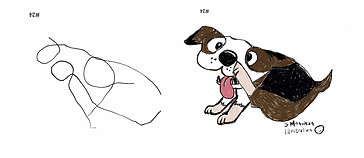Grade One - Art All Around
Lesson 4 –"Fantasy - The World of Imagination"
INTRODUCTION
When you use your imagination, you form a picture in your mind of something not now present or especially of something you have not known or experienced.
You have all used your imagination - Do you play pretend games? Do you make up stories or daydreams of adventures in time machines or space ships? Do you listen to fairytales and form pictures of the stories in your mind? Have you ever imagined what creatures from outer space might look like? You have probably drawn pictures of monsters which you have imagined. Sometimes artists combine their ideas with the imagination of storytellers. Paul Klee did that in Sinbad the Sailor.
Artists also paint from their own dreams and imaginations. Henri Rousseau was a gentleman who also wrote poems and music. He taught himself to paint. Can you notice his gentle feelings in The Sleeping Gypsy? Joan Miro used pure imagination when he painted People and Dog in the Sun.
MATERIALS
1. Sinbad the Sailor, Paul Klee, Swiss (1879-1940)
This picture was inspired by a battle scene from the comic opera called The Seafarer, is a character in the folktales from the Near East called The Arabian Nights. Sinbad of Baghdad goes off on many sea voyages and has many adventures - sailing through caves and meeting sea monsters - but Sinbad always returns home safely and with more treasures. Such wonderful stories were passed on from one storyteller to another, each adding another adventure from his own imagination - the stories were passed on to a writer of an opera and then on to the artist to add his imagination for a painting. Perhaps this picture is of the large cave he sailed into. "The stones of the mountain are of crystal, rubies and other precious stones." Because there is no horizon, the green and black background might remind you of a cave. The sailor is in the little boat fighting three sea monsters. He has attacked one and we see two giant drops of its blood. The pattern of colorful fish is repeated in the boat and Sinbad's shirt. Is the blue in the shape of a wave?

2. The Sleeping Gypsy, 1897, Henri Rousseau, French (1844-1910), 51" x 6' 7", oil on canvas, The Museum of Modern Art, NY
It is still and quiet in the desert and the person is in the happy world of dreams. The figure is in brightly colored clothing. It is free from the fear we would have if we saw a savage lion. The lion will do no harm, perhaps it is even a pet? The land is barren and lonely, but Rousseau provided something to drink and music to play when the gypsy awakens. notice the moonlight shining on the lion's tail and mane and on the gypsy's shoulder. Notice the hair like folds of cloth is different from the lion's mane - also hair. How would your feelings about this painting change if there were trees, flowers, grass or people?
Look at the dimensions! This painting is quite big. Compare it to something in the room - a wall, a whiteboard, the height of the teacher!

3. People and Dog in the Sun, Joan Miró, Spanish (1893-1983), Kuntsmuseum, Basel, Switzerland
Joan Miró was a Spanish surrealist painter and sculptor.
This painting is fun to look at and find the people and the dog. Can you find the right side up? There might not be one. Whenever he placed a drop of paint on a canvas, Miró would imagine it as something - a dog, a man etc. Sometimes he would make collages of real things such as screwdrivers, carburetors or other found objects. Then he would paint those combined shapes on a canvas and imagine them as something else in the process.

4. Blue Donkey, Marc Chagall, Russian (1877-1985)
Chagall was a Russian-French painter who is associated with the modern movements after impressionism. He produced a series of great works in his innovative style that he become exceptionally popular in the modern day thanks in part to his vibrant colours and mystical scenes.
Chagall also went far beyond just oil on canvas, Chagall's stainglass windows also becoming respected. There were also plenty of experiments with other mediums and art movements as Chagall looked to push his skills as far as possible.

He painted other imaginatively colored Donkeys, as well!


Optional projects:
Draw like Miró!
Miro would often make a mark on the paper, with nothing in mind, then turn it into an imaginative masterpiece!
Try the scribble game with the class and see where their imaginations can take them.
MATERIALS
-
Paper (any kind or size; we’ve even done this on paper napkins)
-
Pens, pencils, crayons, or markers (again, anything goes)
1. Each person scribbles something quick on their sheet of paper. Don't think about it! Just do it.
2. Swap scribbles with a friend (or, if more than two people are playing, each can hand theirs to the person on their left).
3. Look at the scribble in front of you to see what the lines suggest or remind you of (you may want to turn it upside down and various ways to look at it from different angles).
4. Finish the scribble drawing by adding your own lines and marks, turning the scribble more into the thing it reminds you of.
Examples:


